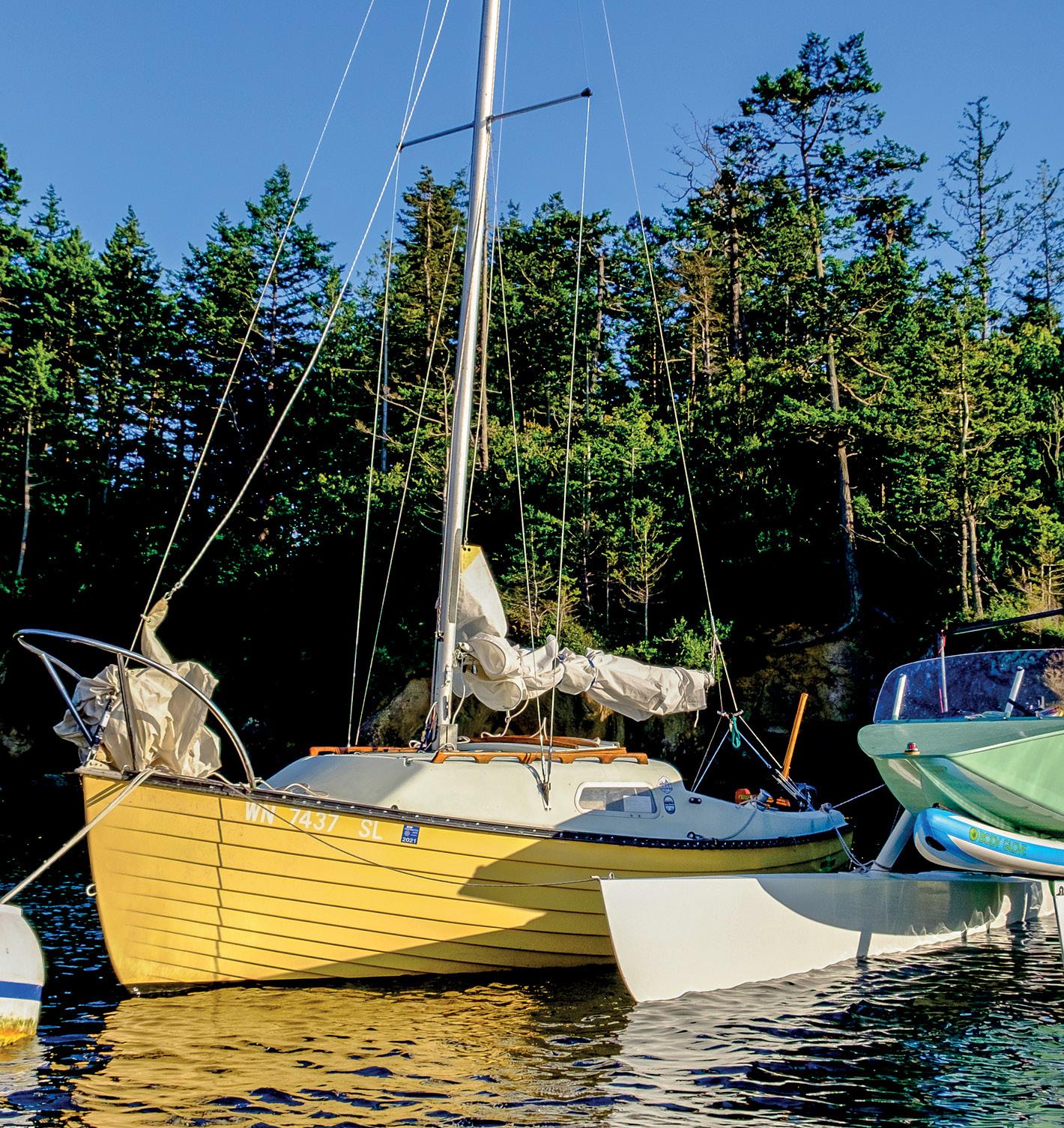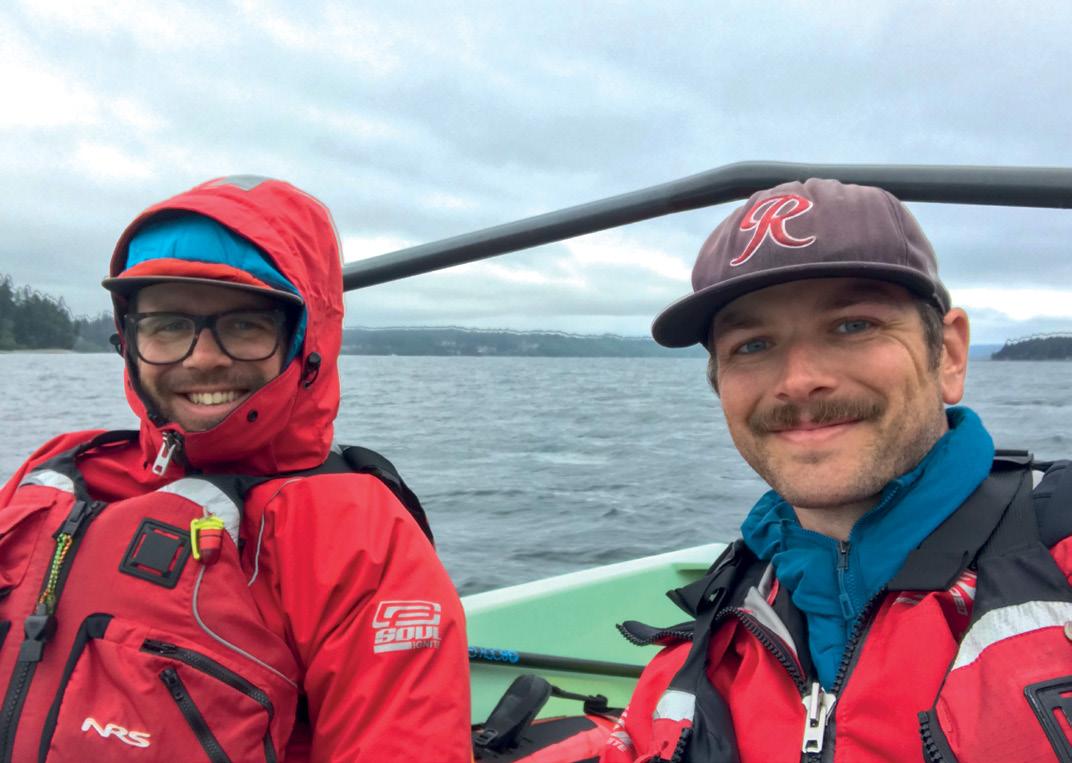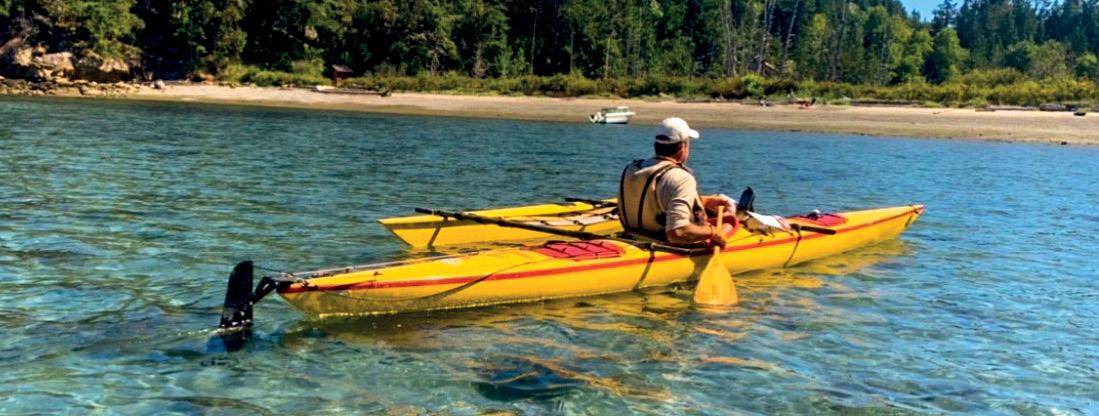
15 minute read
A Trio of Small Craft Cruising Stories
by 48° North
SMALL BOAT CRUISING IN THE PNW
THREE BOATS, THREE PERSPECTIVES
There’s almost no wrong cruising approach—large and luxurious or tiny and rustic, distant or local, by sail or power or paddle. But there’s something special about going small. It’s the small craft sensations of bliss, freedom, wonderment, and fun captured in these three unique stories shared by 48° North readers.
First, Nate Rooks gives us a view from the helm of his oneof-a-kind power cat, Grasshopper. Jim Emery tells the story of buying a new-to-them small sailboat to teach the family to sail and cruise. Lastly, Tim Tanner shares his escapades rowing and camp-cruising around the San Juan Islands…
HOP TO THE SAN JUANS CHOOSING ADVENTURE ON AN UNUSUAL CRUISING CRAFT
By Nate Rooks
After spending a year-and-a-half living in Vancouver, British greeted by the sun along Camano. We stopped for a toast to Columbia, I moved back home to Puget Sound this June. Both our maternal grandparents, whose ashes we spread there last the Canadian scenery and the people are special, but certain summer. Encouraged by the current, we sliced up the Swinomish border-restricting world events made being away from my Slough, bursting past the rail bridge to see the beautiful, family and home waters no longer tenable. As soon as I got familiar peaks of Lummi, Guemes, and Cypress rising to greet us home, the mission was clear: get Grasshopper in the water and like old friends. We stopped for another toast at Guemes Island, head to the San Juans. where our paternal grandparents are buried, and lamented
“What is that thing, anyway?” Funny, Grasshopper and I never the familial battle which caused us to lose the cabin they built get asked that question! Not three times at the gas station, or there in 1957. In the wake of that travesty, Coop and I resolved five times at the boat launch, or a dozen times at the marina... to always share what we had and to find other ways to make the But seriously, folks, it’s a freaky-looking boat that happens to be San Juans ours. the most practical boat I’ve ever been aboard.
Built by multihull mage Russell Brown, it started as an experiment to build an efficient boat out of orphaned parts. Russell’s alchemy turned discarded 20-foot Tornado catamaran hulls, an extra-long-shaft 15hp Honda, leftover carbon mast sections, and spare composites into this beach-cat-runabout. As wild as it looks, it’s really a stable and dry “pickup truck of the seas.” The whole thing only weighs 500 pounds—including the engine!— and has one hell of a window sticker tagline: 15hp = 15 knots = 1 gallon/hour.
Russell’s favorite use for Grasshopper was mobbing from Port Townsend to Desolation Sound over two days: roughly 100 miles, 7 hours, and 7 gallons of gas from PT to Lasqueti; then about the same again up to Desolation.
That trip obviously can’t happen right now, but my brother Coop and I figured we could use those cruising capabilities to catch up to our third brother, Ted, and his girlfriend, Emily, already in the San Juans after a couple of days Yes, two brothers this size fit comfortably under that orange tarp! aboard their Montgomery 17, Over Easy.
The forecast kept getting worse as our Tuesday departure “Hopping” makes you do things you wouldn’t do in any other date approached. “Sunny and 70s” slid to partly cloudy, then to boat, finding a weird place that eschews any normal Venn windy and rainy. We went to bed Monday night disheartened, diagram overlap between sail and powerboats. From a sailor’s thinking our plans might get postponed. “Wait, what?!” we perspective, you’re so amazed by COGs (course over ground) asked ourselves incredulously as we woke up on Tuesday in the teens that you feel like you can go check out that little morning to a gray drizzle. “We rowed and sailed a fat dinghy to bay over there well off course or circumnavigate the island you Alaska through squalls and gales... we can enjoy a motorboat just got to because it only takes a few happy minutes. For those ride to the San Juans regardless of the weather.” With that, we used to most powerboats, the efficiency tempts that Prius-driver threw on our drysuits, loaded up Grasshopper, and cast off the smugness. We used 20 gallons over the four-day cruise from lines. When in doubt, choose adventure. Bainbridge to the San Juans and back. One of Puget Sound’s
Thanks to Grasshopper’s ability to effortlessly cover ground, ubiquitous 50-foot planing K-Swiss shoes (probably named we were able to get pretty creative with our float plan. We Perseverance) would be lucky if it managed even one hour wakestarted by hopping up the inside of Whidbey Island, finally making around the Salish Sea on that amount of dino-juice.

Cooper (left) and Nate (right) Rooks. Does anybody have more fun on the water?

One of my favorite parts of hopping is how the combination of efficiency, handling, and 1-foot draft encourages you to get off the bee-line and hug the coast or get so close you can see the bottom whizzing under the hulls. Might as well go catch that bay’s eddy, gaining 2 knots “against” the current. Might as well do Seattle to the San Juans and back in four days through rain and wind!
When I got Grasshopper, one of my first goals was extended camp-cruising. I love sleeping aboard—we exclusively slept aboard Bunny Whaler for the R2AK—so Russell and I made a platform to span the bench seats in the pod, creating something like a 6'x5'
By Jim Emery
Will and I met at the Marina Cafe, a spot known for its homemade pastries and strong cups of coffee. I had been talking with him about buying his boat for some time and had even gone through some close calls. Finally though, he was replacing his boat and a decision had to be made. Over coffee, he described all the reasons to love the Hutchins Com-Pac 19 and when finished, the deal was done. Decision made.
Then, two days later, the mandate went out to stay safe, stay home.
Owning a boat at a time when recreational boating is discouraged presented some problems. It also created some opportunities. We had plenty of time to get the boat ready, learn its systems and clean it up. In my head, I started building the list of boat projects that all small boat owners seem to be constantly compiling. While we were not supposed to sail, there was no prohibition against being aboard at the dock so the kids and I took to the process with enthusiasm. truck bed—just enough for two big guys to sleep comfortably. A generic rainfly (the same one we used for R2AK) and some tent poles work perfectly to create a dry Grasshopper shell.
Though short, our trip served up that treasured San Juans magic. Smells, sounds, and feelings jostling deep-seated memories. Epic forest hikes through burn-buttressed old growth. Time melting like Dalí clocks. More bald eagles than Bayliners. Each morning began with rolling up the tent's sides, Jetboiling some coffee, and peering out of our floating pickup-truck bed. Nothing beats a reflective morning spent boatwatching in a beautiful anchorage. We even had one of those hilarious “what the heck are you doing here?!” run-ins, stumbling upon Russell Brown himself and tying up to his R2AK-famous Gougeon 32, Incognito. Accidentally running into friends on tiny, otherwise-empty islands feels like the universe conspiring with you.
All in all, we did about 250 miles in 20 hours of driving on 20 gallons of gas—not quite reaching the tagline economy figures, but pretty good for two 200-plus pound dudes, gear, and four days worth of Rainiers.
While sailing remains the undisputed heavyweight champ of environmentally-friendly propulsion, Grasshopper proves the alternative doesn’t have to involve twin diesels or twice that many outboards, multiple heads, an ice maker, or 60 feet of lineal guest moorage. And it was merely the first salvo from Russell to demonstrate a better way; he now has other, more efficient designs. If you’re interested in more efficiency, capacity, and wild looks, keep an eye out for his new power
A SMALL BOAT, A LOT OF LEARNING, & BIG TIME FUN
single-outrigger design!

Elakha, the Emery family's adventure and social distancing platform.

Finally, our preparation and the easing of restrictions came together and we were able to take the boat out sailing. Having two daughters as crew made learning to sail the Com-Pac easy and enjoyable. It also provided a way to get outside while maintaining the social distancing that has become part of our current reality.
We started out with day sails around Port Townsend Bay. It was on one of these trips that my family decided the boat should be called Elakha, the Chinook word for sea otter.
Friends sailed with us to Mystery Bay to help learn the circuitous course into Kilisut Harbor. A circumnavigation of Marrowstone Island gave us a chance to test our knowledge of tides and currents. Years of sea kayaking provided an awareness of these forces that proved equally applicable to a 19-foot sailboat.
The next adventure brought us sailing down to Port Hadlock for cheeseburgers at the Ajax Cafe Boat Shack. Winds were light and we ghosted along, sometimes wondering if we were making any headway. As Carly Simon and Heinz Ketchup told us, anticipation was a fantastic sauce. The Ajax Boat Shack makes outstanding meals, but rarely has a cheeseburger tasted as delicious as it did after a slow trip on a warm summer day across Port Townsend Bay.
As our comfort level increased, we started making overnight trips farther afield. When compared to our nights in backpacking tents, the cabin of the Com-Pac 19 provides spacious and robust accommodation for two adults and two children. A hearty dinner and a glass of wine certainly make sleeping quarters that much more inviting.
My next step is learning to anchor. A friend said that during my first night at anchor, I should expect to get no sleep. That remains to be seen, but I am looking forward to trying and building that experience.
A Com-Pac 19 is not going to win any races or out-maneuver most other boats, nor would many cruisers classify its interior as luxurious. As a family learning to sail, however, the Com-Pac 19 has been a fantastic boat for us. It is forgiving for beginners; but more importantly, it opens the entire Salish Sea for our cruising exploration and enjoyment.
It also provides a way to get out on the water while staying safe during the pandemic. When we get on the other side of Covid-19 and look back, we will not remember it as the summer we lived through a pandemic, but as the summer we learned to sail in our Com-Pac 19.
NAVIGATING A SMALL BOAT ADVENTURE DURING A PANDEMIC
By Tim Tanner
In any normal year, I’d typically get two or three rowing trips under my belt in my home away from home, the Pacific Northwest. But the shutdown changed all of that—2020 is not a “normal” year. This year, I was grateful for one. And, imperfect though it was in certain ways, it delivered on all fronts that matter.
I successfully sheltered in place without leaving the county in which I live—Marin, California. Luckily, I truly love my home turf of Tomales Bay. Conveniently, the bay is walking distance from my house and it’s beautiful, but it has limitations. It's only about one mile wide and fifteen miles long, so it can get a bit Groundhog Day-ish. When I need to get in some serious miles and experience an adventure, I go north.
I was quite reluctant to go anywhere due to the pandemic, but I convinced myself that I could go on this trip and not be close to anyone. The first logistical hurdle of my journey was the road trip from Inverness to my friend John’s house on Guemes Island. Owning a VW diesel really helped because I knew I’d only need to stop once for fuel during the 900 mile drive.
I loaded the car with all my gear including plenty of water, food, masks, and hand sanitizer. I did not want to make any unnecessary stops. Then, I was off to Portland where I had reserved a yurt on a farm for one night to split the drive. I chose the yurt so that I wouldn't have to interact with any humans, only the pigs and goats on the farm. After a peaceful night’s sleep, I got up and drove straight to Guemes Island and was greeted by John and his wife, Deb, who were the most gracious hosts I could ask for.
John was to be my traveling partner on this trip, and was generous enough to provide our boats. He chose to paddle his 19-foot Kevlar Easy Rider, which he paddled in the first R2AK. I decided to row his 18-foot Odyssey Rantilla Front Rower, which John built for the Seventy48 Race. Fortunately, I rowed his boat last year, so I was familiar with the forward facing rower. I typically row backwards in my Maas Aero Shell or my Angus
The author rowed the unique front-facing Odyssey Rantilla, seen here without duct tape repairs.

Photo by John Strathman. RowCruiser. I figured it would be best if we were both looking in the same direction for a week, instead of one of us forward and the other backwards.
I prefer to map out my trips beforehand, although I never seem to stick to the plans. We had a general sense of when we wanted to launch and where we would camp. The main goal was to get to Sucia Island, as I had never been there before and have heard a lot of good things about it.
John plying clear blue shallows in the Kevlar Easy Rider, his R2AK veteran.

We loaded up John’s two boats, and our trip was officially underway. It was great to finally be up north, where there was open water and space. It was freeing to trade my workday mask for sunglasses and sunscreen while on the boat. We made a loop from Guemes and camped at Matia, Patos, Jones, Blind, Doe, and Cypress Islands. It was a bit too crowded at both Sucia and Jones Islands, but we were pleasantly surprised everyone was practicing social distancing and wearing masks.
Each island had its unique charm: the hiking trail at Matia was lush; Patos had a historic lighthouse; although small in size, Blind Island offered some campsites and was a short row to Orcas Island to restock our beer and ice. The first days of the trip went without a hitch, and then there was Doe Island.
Nearing the end of our trip, we rowed around little Doe Island to try and find a decent location to beach the boats for the night. Unfortunately, there weren't any ideal spots available, so we rested the boats on two logs and tied them to a tree— fingers crossed.
All was well until around 11:30 that night when a kayaker, who was camped closer to our boats, said, “I think you guys should check on your boats. We can hear them banging together.” John and I both jumped out of our tents at the same time. Still dressed in our long johns, we ran down the trail to find both boats full of water and waves crashing over them. We spent the next couple of hours bailing the boats, collecting our jetsam from the beach, and watching the wave activity. Eventually the water receded enough, and we felt we could head up and change out of our wet clothes and try to get back to sleep. The next morning we woke up to assess the damage. One of the Easy Rider’s outrigger poles punched four holes in the Odyssey. The three holes located just above the waterline were concerning enough, but the real threat was the fourth one, which would be underwater.
At this point, we still had two crossings and one more night of camping on Cypress Island to go. Fortunately, John had packed duct tape in a dry bag, and we both had a bit of ingenuity and can-do attitude. What else were we going to do? We used the duct tape to patch the holes, making the repairs both inside and outside the boat.
Setting off in the damaged craft, I’m confident that I made the crossing in record time. I stared at the patch job the entire time I rowed. I was ready to bail, if needed. Amazingly, the duct tape held perfectly.
Upon reaching Cypress, we hiked up to Eagle Cliff to get a birds eye view of the crossing that the duct-taped boat successfully endured. I took a moment to appreciate the exquisite San Juan Islands vista, and breathed a sigh of relief.
Our DIY repair job held for our final day as we completed our loop back to Guemes. As soon as this journey was over, the next adventure began—getting back home to California and evacuating my family from our home due to nearby fires. There really is nothing “normal” about this year.
Looking back on it, though, this was another great rowing trip to the Pacific Northwest; as they always are. How could it not be when exploring new waters from a small craft with a cherished friend? Stories and memories are seldom forged without mishap, and row-cruising tends to be memorable—even when there isn’t so much duct tape saving our bacon.

The author at home on a rowing craft in his chosen adventure playground, the Pacific Northwest.










